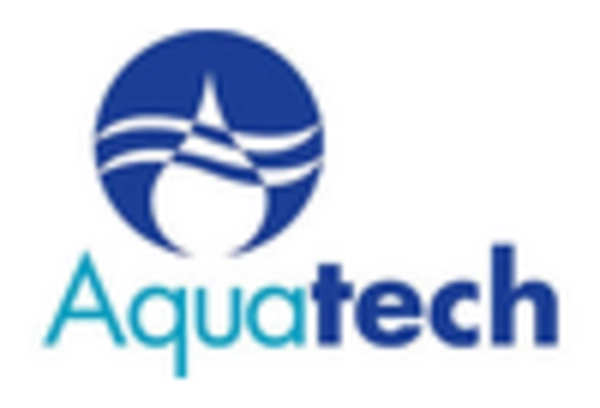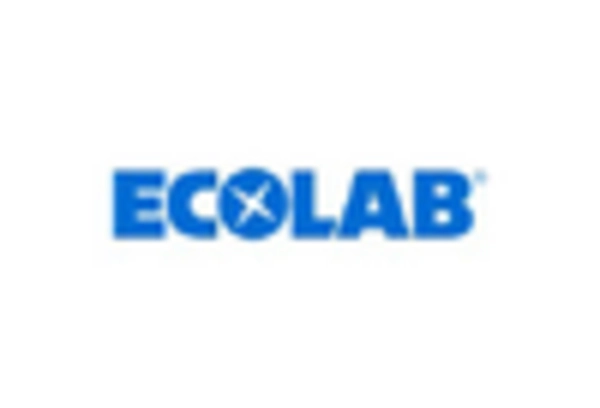Increasing Water Scarcity
The Agricultural Wastewater Treatment Market is experiencing a surge in demand due to the escalating issue of water scarcity. As agricultural practices intensify, the competition for freshwater resources becomes more pronounced. This scarcity compels farmers and agricultural businesses to seek efficient wastewater treatment solutions to recycle and reuse water. According to recent data, approximately 70 percent of the world's freshwater is utilized for agriculture, highlighting the critical need for effective wastewater management. The treatment of agricultural wastewater not only conserves water but also mitigates environmental impacts, thereby driving the market forward. As water resources dwindle, the emphasis on sustainable water management practices is likely to bolster the Agricultural Wastewater Treatment Market.
Economic Incentives and Funding Opportunities
Economic incentives and funding opportunities are emerging as significant drivers for the Agricultural Wastewater Treatment Market. Governments and financial institutions are increasingly offering grants, subsidies, and low-interest loans to encourage the adoption of wastewater treatment technologies. These financial incentives lower the barriers to entry for farmers and agricultural businesses, making it more feasible to invest in advanced treatment solutions. Additionally, the potential for cost savings through water reuse and reduced environmental compliance costs further enhances the attractiveness of these investments. As more stakeholders recognize the economic benefits associated with effective wastewater management, the Agricultural Wastewater Treatment Market is likely to experience robust growth, supported by favorable economic conditions.
Rising Awareness of Environmental Sustainability
The growing awareness of environmental sustainability is a key driver for the Agricultural Wastewater Treatment Market. As consumers become more conscious of the environmental impacts of agricultural practices, there is an increasing demand for sustainable solutions. This shift in consumer behavior encourages agricultural producers to adopt wastewater treatment technologies that minimize pollution and promote resource conservation. The market is likely to benefit from initiatives aimed at reducing the carbon footprint of agricultural operations. Furthermore, sustainable practices such as nutrient recovery from wastewater can enhance soil health and crop productivity, creating a positive feedback loop. As a result, the Agricultural Wastewater Treatment Market is expected to expand as stakeholders prioritize environmentally friendly practices.
Technological Innovations in Treatment Solutions
Technological advancements play a pivotal role in shaping the Agricultural Wastewater Treatment Market. Innovations such as membrane bioreactors, advanced oxidation processes, and anaerobic digestion are revolutionizing the efficiency and effectiveness of wastewater treatment. These technologies enable the removal of contaminants and pathogens, ensuring that treated water meets safety standards for agricultural reuse. The market is projected to grow as these technologies become more accessible and affordable for farmers. Furthermore, the integration of smart technologies, such as IoT and AI, into treatment processes enhances monitoring and management capabilities, potentially leading to improved operational efficiencies. As a result, the Agricultural Wastewater Treatment Market is likely to witness significant growth driven by these technological advancements.
Regulatory Frameworks and Compliance Requirements
The Agricultural Wastewater Treatment Market is significantly influenced by stringent regulatory frameworks aimed at protecting water quality and public health. Governments and environmental agencies are increasingly implementing regulations that mandate the treatment of agricultural wastewater before discharge. These regulations often require farmers to adopt specific treatment technologies and practices, thereby driving demand for wastewater treatment solutions. For instance, the implementation of the Clean Water Act in various regions has led to increased scrutiny of agricultural runoff and wastewater management practices. Compliance with these regulations not only helps in avoiding penalties but also enhances the sustainability of agricultural operations. Consequently, the Agricultural Wastewater Treatment Market is poised for growth as stakeholders seek to meet these evolving regulatory demands.

















Leave a Comment